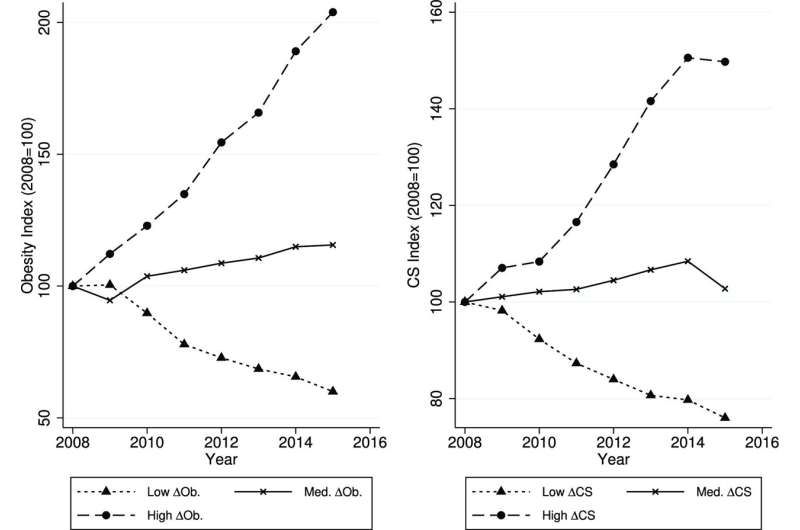This article has been reviewed according to Science X's editorial process and policies. Editors have highlighted the following attributes while ensuring the content's credibility:
fact-checked
trusted source
proofread
C-sections in Mexico increase with obesity level and health care specialization: Study

Cesarean section (C-section) procedures have increased dramatically around the world in the recent decades. Overweight and obesity rates, common risk factors for pregnancy outcomes and for C-sections, are also on the rise—creating a major health issue in low- and middle-income countries. Published in The World Bank Economic Review, new study from the University of Illinois Urbana-Champaign investigates how high obesity levels lead to hospital specializations that affect the frequency of C-sections in Mexico.
"Of course, obesity is a medical factor for C-sections; however, when we started this project, we did not believe it to be the only explanation for the high rates. Our hypothesis was that hospitals with a higher pool of obese patients become specialized in C-sections, and therefore will be more likely to perform the procedure," said study co-author Catalina Herrera-Almanza, assistant professor in the Department of Agricultural and Consumer Economics, part of the College of Agricultural, Consumer and Environmental Sciences (ACES) at Illinois.
The study correlates patient data from 226 public hospitals across Mexico from 2008 to 2015 with birth records that contain information on birth-type delivery, birth outcomes, and maternal characteristics.
The main analysis focuses on mothers with low-risk pregnancies to eliminate obvious medical reasons for a C-section. Thus, the sample excludes women under 18 and over 35, those carrying multiple children, births under 37 weeks of gestation, and women with more than 20 prenatal visits.
The researchers found that the individual probability of a woman having a C-section is correlated with high levels of obesity measured at the hospital level, supporting the hypothesis that doctor specialization leads to increased use of the procedure.
C-section rates in Mexico doubled from 23 percent in the 1990s to 46 percent in 2016, which is well beyond the World Health Organization's (WHO) recommended rate of 10–15%. At the same time, at least 72 percent of the adult population in the country is overweight or obese.
"Mexico has one of the highest C-section rates in Latin America, but there are huge differences across different sectors. The private sector uses C-sections very intensively, while it's used a lot less in public hospitals," said co-author Fernanda Marquez-Padilla, Centro de Estudios Economicos, El Colegio de México.
The research team ruled out other factors driving the increase in C-sections, including maternal characteristics such as education and age. To exclude the possibility of women selecting a hospital based on specialization, the study limited the analysis to municipalities with no more than one facility. Moreover, as these are public hospitals where payment doesn't depend on procedure, there are no monetary incentives for doctors.
"The study is conducted within a public health care setting that is resource-constrained and hence the lessons we learn from this context are likely to be informative for other developing countries. The findings are likely to be useful for countries that are following a similar path in terms of increasing C-section rates and obesity trends," Marquez-Padilla noted.
The hospital data do not include obesity information for individual women, so the researchers constructed a measure that allows them to gauge the overall obesity rate for hospitals. They used patient discharge data to identify obesity-related diseases, such as hypertension, diabetes, and heart disease, to create a hospital-level obesity index.
"We built this obesity measure from discharge records using ICD codes, the WHO medical classification of health data. Our paper makes an important methodological contribution as we design a reliable obesity proxy, which can be used by other researchers in different countries, as long as there is hospital discharge data available," noted study co-author Silvia Prina, Department of Economics, Northeastern University.
Patient outcomes
The researchers also investigated the consequences of the increase in C-sections and what it means for maternal and infant health.
"We divided birth outcomes into delivery-related and delivery-unrelated, as we would only expect to see improvements in outcomes that doctors can affect," Marquez-Padilla said. "We do, in fact, find positive effects for mother survival, decreases in birth injury and birth trauma, and improvements in Apgar scores, which indicates a baby's health at birth. Furthermore, we show there's basically no effect on birth weight, which is unrelated to delivery type, except for very heavy babies, which correlate with obesity and overweight in the mother."
The study also found better outcomes for vaginal births as C-sections increased. This is likely because the riskiest vaginal births are moved to the C-section group, so the average risk of women delivering vaginally is decreasing, Marquez-Padilla said.
The researchers emphasize that these findings do not indicate C-sections are always preferable.
"C-sections are good when they're necessary, but they shouldn't be used when they're unnecessary. In an ideal world, you will want high-risk women to go to the highly specialized C-section hospitals and low-risk women to deliver at hospitals that specialize in vaginal births," Herrera-Almanza said. "One policy implication is that patients should be identified and sorted in terms of the procedure they need and be directed to the best hospital for that procedure."
Reducing maternal and infant mortality is part of the United Nations' Sustainable Development Goals, and C-sections can help save the lives of mothers and children. However, overuse may lead to negative health consequences and waste of resources. Thus, it is important to understand how to optimize the use of the procedure in developing countries, the researchers concluded.
More information: Catalina Herrera-Almanza et al, C-Sections, Obesity, and Healthcare Specialization: Evidence from Mexico, The World Bank Economic Review (2023). DOI: 10.1093/wber/lhad022




















